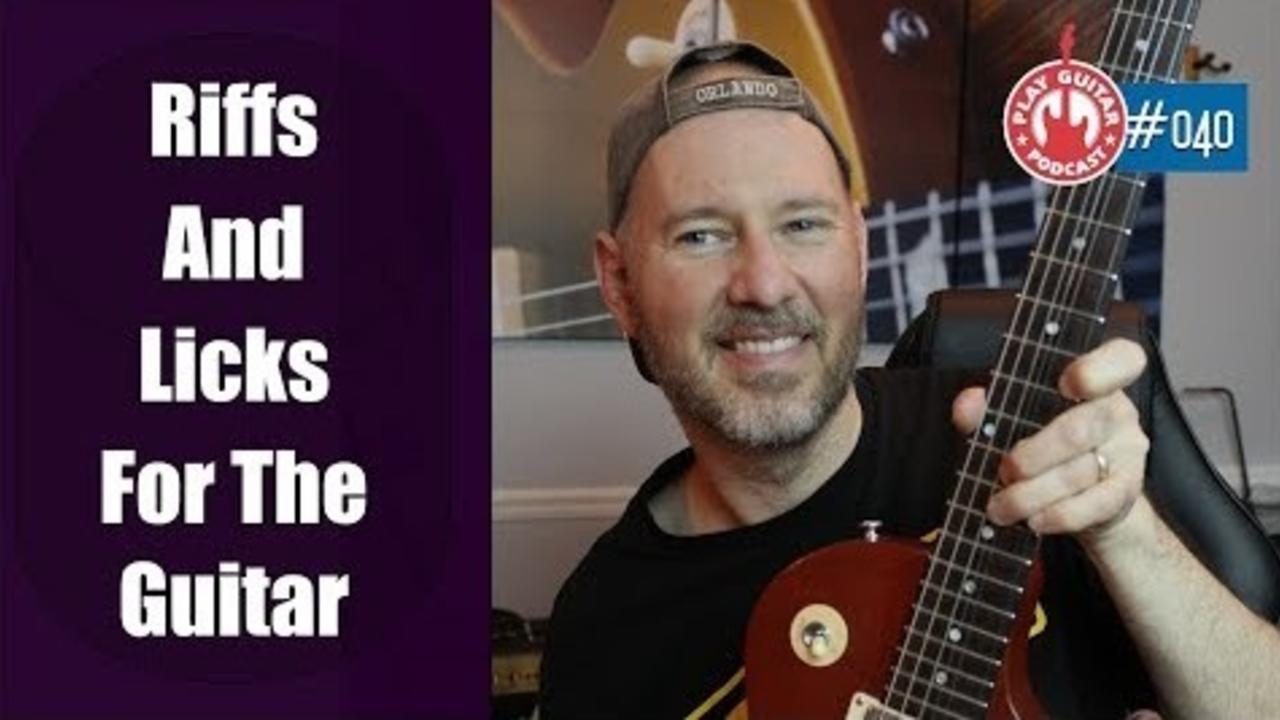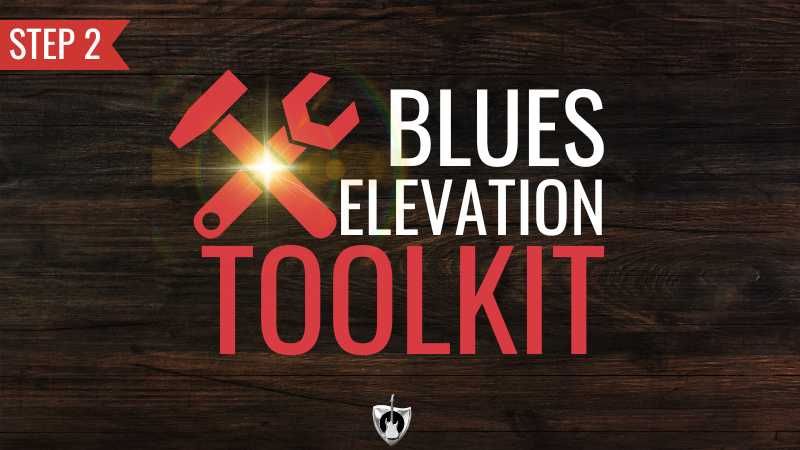Licks and Riffs - 040

Today, I show the importance of, the difference between, and how to use guitar licks and riffs effectively.
Guitar licks and riffs are so cool, and so much fun! You grab your guitar, learn a few notes and you are playing your favorite songs or your favorite parts of songs in an instant.
They are the one of the big reasons that we put so much time into learning the guitar. Being able to play just like or close to our favorite songs and players is a big rush. And it can be addicting.
And it starts right away. Do you remember the first time you played something on the guitar that sounded just like one of your favorite songs? I do. It’s awesome!
You got the tab or the video lesson, spent some time working it out on the guitar, and before you know it you are smiling and having the best time.
As you progress over time you start to pick up a good deal of these little musical statements. They might be the main part of a well known song or just a small part of a guitar solo. But, they are cool, they sound good, and you can play them over and over without getting tired of them.
I’m talking today about licks and riffs. Two very important but easily confused parts of guitar playing. I go over:
- What they are
- How they are different
- Why you would want to learn other guitarists licks and riffs
- How you come up with them
- Ways to get the most of them
- and, Some examples of licks and riffs of mine to demonstrate how to make them and their value.
I had always heard about licks and riffs but never thought too much about it. I just set out to learn the songs that I loved and all of the parts. Even in all of my different lessons with different teachers, I would learn a lick or a riff but it was never really clear what the difference was. It was never spelled out for me.
In fact thinking back on it, most of the time those two words were used interchangeably.
But now, knowing just how important guitar licks and riffs are to players, I can see that there is a lot of benefit in really understanding what these two terms really mean. Once you understand them and their differences, you can use these great devices to your advantage.
For me, once I really began playing lead guitar a lot, getting my guitar licks and song riffs in order really gave me the tools I needed to feel comfortable playing in bands. Bringing this to students attention and building a good collection of both can really move a new player forward and give clarity to an experienced player.
So, let’s go ahead and take a good look at licks and riffs
What Are Licks and Riffs?
Let’s start with riffs.
A riff is a musical device that is very strong and very memorable. It commonly repeats and you can think of it as the main hook of a song. It’s not the solo and it’s not the fills.
Examples of songs with great riffs are:
- Smoke On The Water
- Enter Sandman
- Iron Man
- Sunshine of your love
- Seven Nation Army
- Etc.
The guitar line becomes a theme that is synonymous with the song. For example, when you think of Smoke On The Water, for a lot of people the main riff of the song comes to mind before the lyrics or any of the other parts.
How about licks.
Licks are devices that are just a part of something larger. They are generally short and could be in a solo or in fills during the main part of the song. They can also be used as a transition or just some sort of decoration.
Licks can also be used to give a familiar sound (your sound) that can be used again and again in different songs. You can easily change them to fit different circumstances and expound on them to create new licks. They can sound very cool, but they are not epic. They are not the centerpiece of a song.
The best way to find famous signature licks is to listen to a lot of different solos from a particular artist. The more you listen, the more you will start hearing some things in common. (Especially from blues players like Stevie Ray Vaughan, B.B. King, and Eric Clapton.) These common phrases are licks that the player thinks represents their own style.
How Are Licks and Riffs Similar?
Licks and riffs are very similar. In fact they are mistaken for each other a lot. Just do a search for “guitar licks” and a lot of the results you get are actually “riff” posts.
They both can be made out of short musical phrases, and they both are based on single note lines. But, you will find that they both occasionally have chords along with those single note lines.
How Are Licks and Riffs Different?
Here is where we can really start to classify these small phrases and use them to our advantage.
Riffs tend to use chords a lot more that licks. Because they are usually the main theme of the song, a few good chords can really fill out a great riff and add to the strength of the sound.
Although there are no rules and licks can have chords in them at times, guitar licks are usually just single notes.
Guitar riffs tend to be voiced lower that licks. Because they are a big part of the structure of the song, riffs trend toward the lower, more powerful notes on the guitar.
Guitar licks are usually voiced higher. Because they are usually part of an instrumental lead of some sort, They are played in a higher register to cut through the mix.
Although this low vs high comparison works the majority of the time, it is not always the case. Take the song Sweet Child Of Mine. The main riff of the song is voiced very high on the guitar, but still is a riff: a major part of the structure of the song.
Another surefire way to tell if you have a riff is if it follows the bassline. In a lot of classic riff-based songs, the guitar and bass double the riff to give it greater impact.
The last way that riffs and licks are different is that riffs tend to repeat a lot. In the same way as chords play in a song, riffs will repeat over and over to keep the song moving forward.
Why Would You Want To Learn Other Guitarists Licks and Riffs
Guitar licks are the bread and butter to Lead guitarists. They are very important! To further your skills as a lead player, it is very valuable to be able to understand what other influential players have done.
Understanding the classic guitar licks of a certain style of music is very similar to learning a language. These licks are the common phrases you will hear and create the atmosphere appropriate to the style. Once you are able to play this “language” you can then take what is common to the style and put your own spin on it.
Learning riffs has a different value to guitar players. Being able to play and understand where these classic guitar parts came from is a valuable tool for songwriting. When you can see how the scales, chords, and rhythm are used to make an effective riff, you will be able to take that information and use it in your own songs. It doesn’t take much to change a riff so that it doesn’t sound like the original one, but still has the same vibe to it.
How Do You Come Up With Guitar Licks and Riffs?
Well, in a perfect world, the inspiration would just come to you and you could create great ones on the fly. And, that happens sometimes, but not often.
For me, the best ones come from analyzing the licks and riffs of other players and then trying to come up with something similar. The process is Learning and Changing.
Find the solos or song riffs that affect you the most. The ones that make you happy and make you want to play guitar. Spend the time to learn them, but don’t stop there. Once you know them, really figure them out.
The trick is to, like I said before, make a few small changes that can completely change a riff or lick into something new and unique. Something that no one has heard before, but still has the vibe that you want to get across.
Something I think is amazing is the sheer amount of different music there is out there. There are only 12 notes available to western music. Just 12. Everything we do as songwriters, and as players are just different combinations of these 12 notes. And the way you arrange these 12 notes can be completely unique to you. Amazing.
How Do You Get The Most Out Of Licks And Riffs
OK, you should definitely have a good understanding of them by now! How do we best use these devices to our advantage?
The first is to know what you want out of them. When you come up with a cool idea on the guitar, think to yourself whether it would be suited more for a lick or for a riff. Try to know what you want from your new idea.
Ask yourself if your idea is best to be used for a single song, or if it is something that you could get a lot more use out of in different songs. Make a clear distinction early on. When you do this, you are much more likely to put this idea to work in the right situation.
Keep a wish-list of riffs and licks that you want to learn. It always happens to me, I’ll hear a song on a tv show, or maybe in a store when I’m shopping that I really want to learn. I try my best to make a mental note of what the song was. By the time I’m ready to start practicing, I can never remember what it was. Try using some sort of note taking app (like Google Keep) on your phone to keep a wish-list of songs available at all times.
Learn one lick or riff at a time and take the time to understand it. At some point, you need to know the “WHY”. Why does this sound so cool. What scales and chords are used. What makes it distinctive?
It could be the:
- Rhythm
- Register
- Tone used or the
- Arrangement of the part.
Analyzing music can be tough at first and you are bound to not get everything correct. That’s OK. It’s a lot like exercising, the more you do it on a regular basis, the easier it gets. There have been several times where I spent the time to really understand something I was interested, and it really paid off. The one thing I learned unlocked the door to many other songs and solos that were similar.
A change of mindset is crucial to getting the most out of licks and riffs.
Instead of thinking: “If I could only play that, I’d be happy”, try thinking something more like this: “If I could only come up with something as cool as that, I would be happy”.
Just memorizing licks and riffs leaves a lot on the table. Trying to copy someone else, especially a famous guitar player, is fun. But, there is so much more to these devices than that. There is so much more in these licks that you can use to really move forward as a musician.
I’ve seen a lot of very good students, who knew a lot of famous licks, who were very frustrated when they tried to start playing in bands. They weren’t communicating, just forcing licks into songs that they might not be appropriate for.
Playing music is like having a conversation. You have to be able to communicate to move the music forward. Just playing other peoples licks all of the time is a lot like answering other people’s question with just famous quotes. Pretty awkward and impersonal.
Examples
So I wanted to play for you a few examples of easy riffs and licks that I came up with today to show you the difference between them and talk about how I came up with them. I tabbed them out for you and you can find them in the show notes at playguitarpodcast.com/040.
All of these are pretty easy and at a medium tempo. I’ll go through them and then also show for the licks how to change them a bit to make them your own.
First is a bluesy riff I came up with in the key of G. I just wanted to come up with something that was catchy and sounded good if it had to be repeated a lot. I used just the basic notes from the minor pentatonic scale. Let’s take a listen.

Next I came up with a lick that you might use in the same style. It is in G as well and also uses the minor pentatonic scale. The difference is it is not quite so repetitive, in a higher register, and uses some bended notes. Here it is:

Next I switched to the key of E minor and tried to come up with something a little funkier and heavier. Notice the power chords I used in conjunction to the single notes.

Last, I came up with a lick that doesn’t have a blues sound. I used the E natural minor scale for this in a very high register. I also added some 16th note triplets for fun.
Challenge
So, for this week, my challenge for you is to get to work. Learn a new riff and a new lick that you like. Try to figure out why it sounds so good and then change it to make it your own. What do you think? Are you up for the challenge.
GET FREE WEEKLY GUITAR LESSONS, PODCASTS, AND MOTIVATION DELIVERED TO YOUR INBOX.
Your information is kept safe. It's never shared with third parties.





